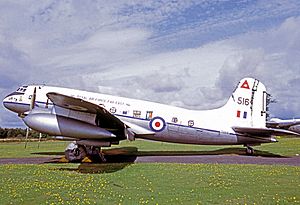No. 48 Squadron RAF facts for kids
Quick facts for kids No. 48 Squadron RAF |
|
|---|---|
| Active | 15 April 1916 – 1 April 1920 25 November 1935 – 7 January 1976 |
| Country | |
| Branch | |
| Motto(s) | Latin: Forte et fidele ("By strength and faithfulness") |
| Battle honours | Western Front, 1917-18: Arras: Channel & North Sea, 1939-40: Dunkirk: Atlantic, 1941-42: Mediterranean, 1943: Arnhem: Rhine: All honours are emblazoned on the Squadron Standard |
| Commanders | |
| Notable commanders |
Keith Park |
| Insignia | |
| Squadron badge heraldry | On an equilateral triangle, a Petrel's head erased |
| Squadron codes | ZW Allocated Apr 1939 - Sep 1939 OY Sep 1939 - Dec 1942 I2 Feb 1944 - Jan 1946 |
Imagine a group of brave pilots flying amazing planes through history! No. 48 Squadron was a special team in the Royal Air Force, which is the UK's air force. This squadron played important roles in both the First World War and the Second World War. They flew different types of aircraft, from early fighter planes to large transport aircraft, helping out in many parts of the world.
Contents
Squadron History
First World War Service
No. 48 Squadron started as part of the Royal Flying Corps on 15 April 1916. This was at Netheravon Airfield in Wiltshire, England. In March 1917, the squadron moved to France. It became the first fighter squadron to use the Bristol F.2 Fighter, a powerful two-seater plane.
One of the squadron's leaders was Keith Park. He was a Major at the time. Later, he became a very important leader during the Battle of Britain. The squadron became part of the Royal Air Force in 1918. This happened when the Royal Flying Corps joined with the Royal Naval Air Service.
In May and June 1919, the squadron traveled by sea to India, based at Quetta. On 1 April 1920, No. 48 Squadron was renamed No. 5 Squadron RAF and officially disbanded.
Famous Pilots of World War I
Many skilled pilots, known as "aces," served in the squadron. An ace is a pilot who has shot down five or more enemy aircraft. There were 32 aces in No. 48 Squadron. Besides Keith Park, some of these brave pilots included:
- Fred Holliday
- John Letts
- Brian Edmund Baker
- Harold Anthony Oaks
- Leonard A. Payne
- Robert Dodds
- John Theobald Milne
- Charles Napier
- Frank Ransley
- Alan Wilkinson
- Thomas Percy Middleton
- William Price
- Charles Steele
- Norman Craig Millman
- Thomas G. Rae
- Owen Scholte
- Harold Johnstone Pratt
- Hugh Leslie Owen
- Roger Hay
- Norman Roberts
- Joseph Michael John Moore
- Arthur Noss
- Maurice Benjamin
Second World War Operations
No. 48 Squadron was started again on 25 November 1935 at RAF Bicester. It became a General Reconnaissance unit. This means they flew planes to gather information and scout areas. They used Avro Anson aircraft for this job.
When the Second World War began in 1939, the squadron flew patrols along the southern coast of England. In 1941, they got new planes called Lockheed Hudson aircraft. Their job changed to being an anti-submarine squadron. They patrolled the North Sea to find and stop enemy submarines. In December 1942, the squadron moved to RAF Gibraltar to patrol the Mediterranean Sea.
In 1944, the squadron returned to the UK. They were given Douglas Dakota aircraft. These were large transport planes. The squadron remained a transport unit until it was disbanded on 16 January 1946. During this time, they operated from Chittagong in India. They carried supplies in the Irrawaddy River valley of Burma.
Post-War Era and Disbandment
The squadron was formed again on 15 February 1946. This happened when No. 215 Squadron RAF was renamed No. 48. Their base was at RAF Changi in Singapore from April 1946 until October 1967.
In January 1951, they received Vickers Valetta transport planes. These were replaced by Handley Page Hastings four-engine transport aircraft in June 1957. The squadron continued to be a transport unit. Finally, they were equipped with the turboprop Lockheed C-130 Hercules, a very famous transport plane.
The squadron returned to the UK on 1 September 1971. They kept flying the Hercules until they were disbanded at RAF Lyneham on 7 January 1976.
Squadron Badge and Meaning
The special symbol, or badge, of No. 48 Squadron is "On an equilateral triangle, a Petrel's head erased."
During the First World War, airmen sometimes put bottle labels on their aircraft. The Bass red triangle was the first registered trademark in the UK. This red triangle was used as the main part of the squadron's badge. The head of a petrel, which is a small seabird, was added to it.



